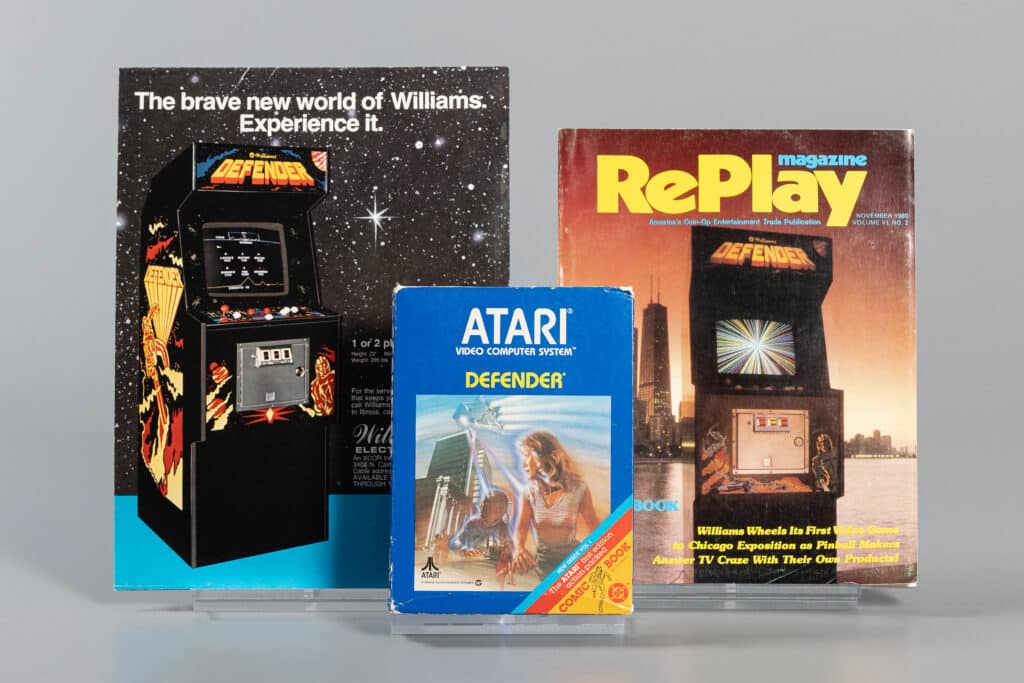Inducted: 2025
The conventional game design wisdom of the early 1980s suggested that many of the best video games were “easy to learn, but difficult to master.” This seemed like sound advice then and now, particularly for engaging casual players who might drop their quarters into a different arcade game if the first proved too hard. Released in 1981, at the height of the arcade video game boom of the late 1970s and early 1980s, Williams’s exceedingly difficult, horizontally scrolling space shooter Defender helped challenge that thinking.

Founded in 1943, Williams Manufacturing released hundreds of coin-operated game titles through the 1970s. By 1980 the company, now Williams Electronics, was best known for its innovative pinball machines such as Gorgar (1979), that used a speech synthesizer to make the game “talk.” The company had little expertise in video games, having produced only a few Pong clones. But with hit video games like Taito’s Space Invaders and Atari’s Asteroids generating many millions of dollars for their companies, Williams couldn’t ignore the rapidly growing video game market any longer. The firm began developing its own video game, and Eugene Jarvis, the same person who made Gorgar “talk,” emerged to lead its efforts, which culminated in Defender, one of the most iconic arcade video games of all time.
When Defender first appeared at the October 1980 Amusement & Music Operators Association Expo, Jarvis and a team including programmers Larry DeMar, Sam Dicker, and Paul Dussault had worked for months to make the game feel familiar, but also entirely different from Space Invaders and Asteroids. Completed just hours before the show opened, the game’s color graphics and physics-based explosion effects looked spectacular. But show attendees were skeptical. Defender asked players to fly around the screen blasting hordes of enemy aliens determined to capture humanoids and turn them into psychotic mutant attackers. Although, the gameplay sounded simple, it was anything but. Because the enemies always behaved in different ways, players couldn’t just memorize patterns as they had on many previous games. The game was even more challenging due to its complex controls, which featured a two-way joystick that allowed players to move their ships up and down, and five buttons: one to thrust, another to reverse, and others to fire a laser, drop a “smartbomb” to clear the screen of enemies, and deploy “hyperspace” to make the player’s ship disappear and reappear in a random area of the screen.
Distributors and operators worried the typical player would last only a few seconds and then quit out of frustration. But that’s not exactly what happened. Some players found the game way too hard, but many others loved the challenge. As Jarvis explained in a 2008 RetroGamer interview, angry players would “want to put their foot through the glass, but then decide they were going to beat the game.” By the Spring of 1981, Defender had surpassed Asteroids as the top earning arcade video game. Williams ultimately sold more than 55,000 units, making it one of the bestselling arcade video games ever.
Defender’s popularity prompted Williams to license the game to nearly every major home console or personal computer of the time, including the Atari 2600, Apple II, Commodore 64, Mattel Intellivision, and ZX Spectrum. Atari alone sold more than 3 million Defender cartridges for its 2600. Williams also released the sequel Stargate in 1981, while Midway introduced its indirect sequel Strike Force a decade later.
Defender was also one of the first arcade video games to feature a scrolling world beyond the initial game screen—made even more apparent by the game’s innovative radar-like mini-map at the top of the screen. In addition, the game popularized the horizontally scrolling shooter, making possible a generation of side-scrolling arcade shooters, such as Scramble (1981), Super Cobra (1981), Choplifter (1982), Gradius (1985), and R-Type (1987).
But the game’s influence goes far beyond ports, copies, sequels, and genres. Its punishing gameplay raised the level of competition in arcades, and it was among the first games to truly separate casual players from more dedicated ones. As Jarvis told author Steve Bloom in Video Invaders (1982), Defender is “not for people who aren’t as dedicated, who just want to have a good time. It’s for game nuts like me.” Those “nuts,” or hardcore players, became an important video game market for decades to come.By challenging conventional wisdom about game mastery and the idea that players would reject more complex arcade video games, Defender introduced new video game possibilities for developers and players alike.
Did You Know?
Williams created a “Golden” Defender cabinet in 1981 to commemorate the company’s 50,000th unit.
Related Content
Honoring Gaming Innovator Eugene Jarvis
Finding Aid to the Sam Dicker Papers




